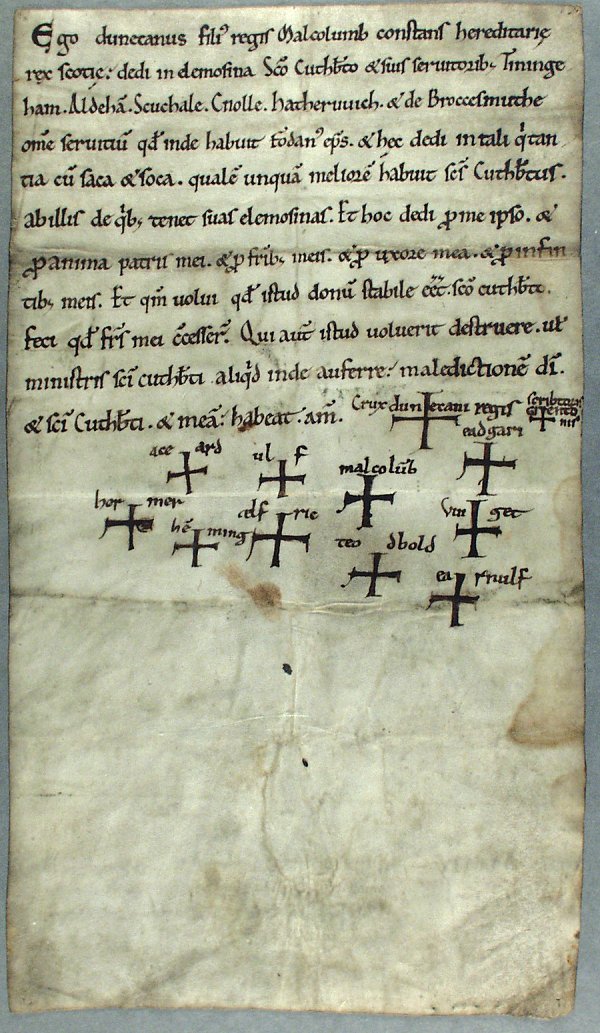Charter of King Duncan II of Scotland, [1093 x 1094] (DCD Misc. Ch. 554. Duncan 1999)
DCD Misc. Ch. 554.

Ed. Duncan (1958) p. 119; facsimile, Duncan (1999) p. 8, and, detail of signa from video-spectral comparator screen, p. 6.
Charter of King Duncan [II] of Scotland for St Cuthbert and his servants.
Undated [November 1093 X November 1094: Duncan king]; David Howlett, Caledonian Craftsmanship. The Scottish Latin Tradition (2000), pp. 6-9, suggests 24 May 1094, on the basis of a minute literary analysis.
The charter echoes certain forms found in Anglo-Saxon diplomas and contemporary Norman charters, using `Ego’ at the beginning, with a moderately elaborate royal style, and concluding with an anathema (`Qui autem istud uoluerit destruere. uel ministris sancti cuthberti aliquid inde auferre; maledictionem dei. et sancti Cuthberti. & meam; habeat. amen.’ [view]). Cf. 2.1.Reg.5 . It records that the king has given `in elemosina’ lands in Lothian with all the service that Bishop Fothad [of St Andrews] had from them, `in tali quie tan tia cum saca & soca. qualem unquam meliorem habuit sanctus Cuthbertus. ab illis de quibus tenet suas elemosinas’ [view], this for [the spiritual benefit of] himself, the soul of his father, his brothers, wife and infants, making the common distinction between the living and his dead father with his soul mentioned. Wishing the gift to be stable he has made his brothers confirm. Twelve crosses, each with an associated name, were written below the text, and then there is a blank space of some 100 mm. to the foot of the document. The single-sided seal is now detached but it is clear that the tongue was attached to the document at the bottom right-hand corner of the face.
The turbulence of Duncan’s brief reign and its sequel amply explains the fact that there is no evidence that his grant took effect, but within a few years later his half-brother Edgar had made another generous grant, see Misc. Ch. 973. Despite the absence of a motive in forging a failed grant the authenticity of the document has been attacked more than once, but Duncan (1999) cites parallels for almost all its apparent peculiarites, and earlier (1958, p. 121) offered a plausible explanation for its chief oddity, the fact that the seal is face down, on a tongue attached to the “wrong” corner: the sheet of parchment was sealed blank and the scribe, perhaps unfamiliar with the norm, then chose to write on the “wrong” side, while his text was not sufficiently long to occupy as much as half the sheet. The scribe has been identified (Bishop & Chaplais VIII) as responsible for a genuine writ of King William II for Durham (Misc. Ch. 973), as well as books in the monastic library, in one of which his name is given as William.
